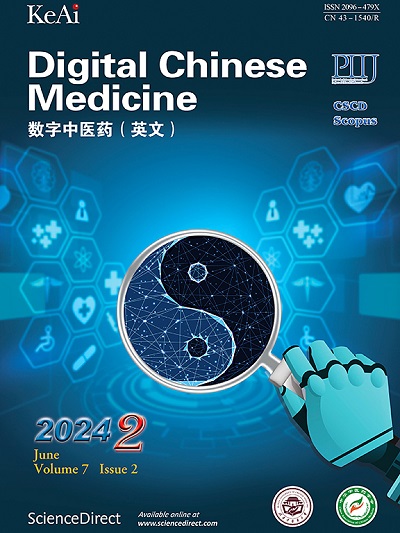Modulation of colonic DNA methyltransferase by mild moxibustion and electroacupuncture in ulcerative colitis TET2 knockout mice
Q3 Medicine
引用次数: 0
Abstract
Objective
To investigate the mechanism of in alleviating colonic mucosal inflammation in ten-eleven translocation (TET) protein 2 gene knockout (TET2-/-) mice with ulcerative colitis (UC) by regulating DNA methyltransferase (DNMT) and DNA hydroxymethylase.
Methods
Male specific pathogen-free (SPF) grade C57BL/6J wild-type (WT) mice (n = 8) and TET2-/- mice (n = 20) were used to establish UC models by freely drinking 3% dextran sulfate sodium solution for 7 d. After UC model validation through histopathological examination in two mice from each type, the remaining mice were divided into four groups (n = 6 in each group): WT model (WT + UC), TET2-/- model (TET2-/- + UC), TET2-/- mild moxibustion (TET2-/- + MM), and TET2-/- electroacupuncture (TET2-/- + EA) groups. TET2-/- + MM group received mild moxibustion on Tianshu (ST25) and Qihai (CV6) for 10 min daily for 7 d. The TET2-/- + EA group also applied electroacupuncture (1 mA, 2/100 Hz) at the same acupoints for 10 min daily for 7 d. The disease activity index (DAI) scores of each group of mice were accessed daily. The colon lengths of mice in groups were measured following intervention. The pathological changes in the colon tissues were observed with hematoxylin and eosin (HE) staining. The concentrations of interleukin (IL)-6, C-C motif chemokine 17 (CCL17), and C-X-C motif chemokine ligand 10 (CXCL10) in serum were detected by enzyme-linked immunosorbent assay (ELISA). The expression of DNMT proteins (DNMT1, DNMT3A, and DNMT3B) in the colon tissues was detected by immunohistochemistry. The expression of 5-methylcytosine (5-mC), 5-hydroxymethylcytosine (5-hmC), histone deacetylase 2 (HDAC2), and DNA hydroxymethylase family proteins (TET 1 and TET3) was detected using immunofluorescence, which also determined the co-localization of TET1 and IL-6 protein.
Results
Compared with WT + UC group, TET2-/- + UC group exhibited significantly higher DAI scores and shorter colon lengths (P < 0.01). Both mild moxibustion and electroacupuncture significantly decreased DAI scores and ameliorated colon shortening in TET2-/- mice (P < 0.001). Histopathological scores of TET2-/- + UC mice were significantly higher than those of WT + UC group (P < 0.001) and were significantly reduced after both mild moxibustion and electroacupuncture interventions (P < 0.001). Serum levels of IL-6, CCL17, and CXCL10 were significantly elevated in TET2-/- + UC group compared with WT + UC group (P < 0.001). Mild moxibustion significantly reduced IL-6, CCL17, and CXCL10 levels (P < 0.001, P < 0.001, and P < 0.01, respectively), while electroacupuncture also significantly reduced IL-6, CCL17, and CXCL10 levels (P < 0.05, P < 0.01, and P < 0.01, respectively). TET2-/- + UC mice showed increased expression levels of DNMT1, DNMT3A , DNMT3B, and 5-mC (P < 0.05, P < 0.01 and P < 0.001, respectively), with decreased expression levels of TET1, TET3, 5-hmC, and HDAC2 (P < 0.001). Mild moxibustion significantly reduced DNMT1, DNMT3B, and 5-mC levels (P < 0.05, P < 0.01, and P < 0.001, respectively), while increasing expression levels of TET1, TET3, 5-hmC, and HDAC2 (P < 0.001, P < 0.001, P < 0.05, and P < 0.001, respectively). Electroacupuncture significantly decreased 5-mC and DNMT3B levels (P < 0.001 and P < 0.01, respectively) and increased 5-hmC and HDAC2 levels (P < 0.05 and P < 0.001, respectively), but did not significantly affect TET1 and TET3 expression (P > 0.05). Compared with TET2-/- + MM group, TET2-/- + EA group showed significantly higher 5-mC expression (P < 0.001). TET2-/- + UC group exhibited markedly increased IL-6 expression and higher co-localization of TET1 and IL-6 in mucosal epithelium, whereas minimal IL-6 expression was observed in the other groups.
Conclusion
Mild moxibustion and electroacupuncture significantly ameliorate colonic inflammation exacerbated by TET2 deficiency in UC mice via epigenetic modulation. Distinct mechanisms exist between the two interventions: mild moxibustion regulates both DNMT and hydroxymethylase, whereas electroacupuncture primarily affects DNMT.
微灸和电针对溃疡性结肠炎TET2基因敲除小鼠结肠DNA甲基转移酶的调节作用
目的探讨通过调节DNA甲基转移酶(DNMT)和DNA羟甲基化酶,减轻10 - 11易位(TET)蛋白2基因敲除(TET2-/-)小鼠溃疡性结肠炎(UC)结肠黏膜炎症的机制。方法采用SPF级C57BL/6J野生型(WT)小鼠(n = 8)和TET2-/-型小鼠(n = 20)分别自由灌胃3%葡聚糖硫酸钠溶液7 d建立UC模型,每型2只经组织病理学检查验证UC模型后,将剩余小鼠分为4组(每组6只):WT模型(WT + UC)、TET2-/-模型(TET2-/- + UC)、TET2-/-轻度灸(TET2-/- + MM)、TET2-/-电针(TET2-/- + EA)组。TET2-/- + MM组给予天俞穴(ST25)和七海穴(CV6)轻灸,每日10 min,连用7 d。TET2-/- + EA组同时在同一穴位电针(1 mA, 2/100 Hz),每日10 min,连用7 d。每日获取各组小鼠疾病活动指数(DAI)评分。干预后测量各组小鼠结肠长度。苏木精、伊红(HE)染色观察结肠组织病理变化。采用酶联免疫吸附法(ELISA)检测血清中白细胞介素(IL)-6、C-C基序趋化因子17 (CCL17)和C-X-C基序趋化因子配体10 (CXCL10)的浓度。免疫组化检测结肠组织中DNMT蛋白(DNMT1、DNMT3A、DNMT3B)的表达。免疫荧光法检测5-甲基胞嘧啶(5-mC)、5-羟甲基胞嘧啶(5-hmC)、组蛋白去乙酰化酶2 (HDAC2)和DNA羟甲基化酶家族蛋白(TET 1和TET3)的表达,并测定TET1和IL-6蛋白的共定位。结果与WT + UC组比较,TET2-/- + UC组DAI评分显著升高,结肠长度显著缩短(P <;0.01)。轻度艾灸和电针均可显著降低TET2-/-小鼠DAI评分,改善结肠缩短(P <;0.001)。TET2-/- + UC小鼠的组织病理学评分显著高于WT + UC组(P <;0.001),轻度艾灸和电针干预后显著降低(P <;0.001)。与WT + UC组相比,TET2-/- + UC组血清IL-6、CCL17、CXCL10水平显著升高(P <;0.001)。轻度艾灸可显著降低IL-6、CCL17、CXCL10水平(P <;0.001, P <;0.001, P <;0.01),而电针也显著降低IL-6、CCL17和CXCL10水平(P <;0.05, P <;0.01, P <;分别为0.01)。TET2-/- + UC小鼠DNMT1、DNMT3A、DNMT3B和5-mC的表达水平升高(P <;0.05, P <;0.01和P <;0.001), TET1、TET3、5-hmC和HDAC2的表达水平降低(P <;0.001)。轻度艾灸可显著降低DNMT1、DNMT3B和5-mC水平(P <;0.05, P <;0.01, P <;0.001),同时增加TET1、TET3、5-hmC和HDAC2的表达水平(P <;0.001, P <;0.001, P <;0.05, P <;分别为0.001)。电针显著降低5-mC和DNMT3B水平(P <;0.001和P <;5-hmC和HDAC2水平升高(P <;0.05和P <;0.001),但对TET1和TET3表达无显著影响(P >;0.05)。与TET2-/- + MM组比较,TET2-/- + EA组5-mC表达显著升高(P <;0.001)。TET2-/- + UC组IL-6表达明显增加,粘膜上皮中TET1和IL-6的共定位较高,而其他组IL-6表达较低。结论微灸和电针可通过表观遗传机制改善UC小鼠TET2缺乏所致的结肠炎症。两种干预之间存在不同的机制:轻度艾灸调节DNMT和羟甲基化酶,而电针主要影响DNMT。
本文章由计算机程序翻译,如有差异,请以英文原文为准。
求助全文
约1分钟内获得全文
求助全文
来源期刊

Digital Chinese Medicine
Medicine-Complementary and Alternative Medicine
CiteScore
1.80
自引率
0.00%
发文量
126
审稿时长
63 days
期刊介绍:
 求助内容:
求助内容: 应助结果提醒方式:
应助结果提醒方式:


